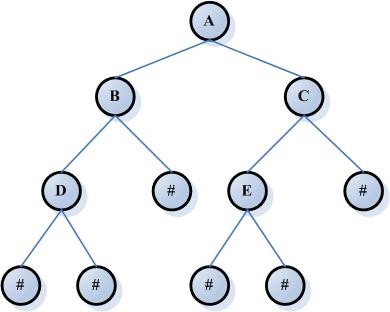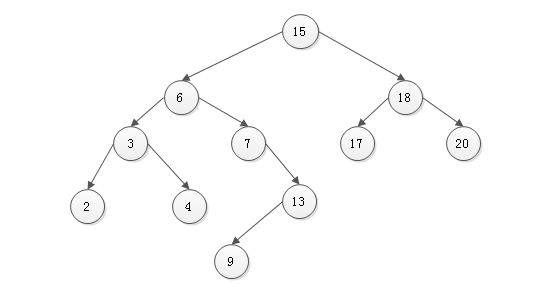摘要:本文主要介绍了set容器和multiset容器的相关内容。
1、基本概念
| set容器 | multiset容器 | |
| 概念 |
所有元素都会根据元素的键值自动被排序, 元素即是键值又是实值,不允许两个元素 有相同的键值,元素值不可以被改变 |
multiset特性及用法和set完全相同, 唯一的差别在于它允许键值重复 |
| 实现 |
set和multiset的底层实现是红黑树,红黑树为平衡二叉树的一种 |
|
2、二叉树
2.1 概念
二叉树就是任何节点最多只允许有两个字节点。分别是左子结点和右子节点。

2.2 二叉搜索树

上面我们介绍了二叉搜索树,那么当一个二叉搜索树的左子树和右子树不平衡的时候,那么搜索依据上图表示,搜索9所花费的时间要比搜索17所花费的时间要多,由于我们的输入或者经过我们插入或者删除操作,二叉树失去平衡,造成搜索效率降低。
所以我们有了一个平衡二叉树的概念,所谓的平衡不是指的完全平衡。

RB-tree(红黑树)为二叉树的一种。
3、常用API
| set | multiset | |||
| API | 意义 | API | 意义 | |
| 构造函数 | set<T> st | set默认构造函数 | mulitset<T> mst | multiset默认构造函数 |
| set(const set &st) | 拷贝构造函数 | |||
| 赋值操作 | set& operator=(const set &st) | 重载等号操作符 | ||
| swap(st) | 交换两个集合容器 | |||
| 大小操作 | size() | 返回容器中元素的数目 | ||
| empty() | 判断容器是否为空 | |||
| 插入和删除操作 | insert(elem) |
在容器中插入元素 | ||
| clear() | 清除所有元素 | |||
| erase(pos) | 删除pos迭代器所指的元素,返回下一个元素的迭代器 | |||
| erase(beg, end) | 删除区间[beg,end)的所有元素 ,返回下一个元素的迭代器 | |||
| erase(elem) | 删除容器中值为elem的元素 | |||
| 查找操作 | find(key) | 查找键key是否存在,若存在,返回该键的元素的迭代器;若不存在,返回set.end() | ||
| count(key) | 查找键key的元素个数 | |||
| lower_bound(keyElem) | 返回第一个key>=keyElem元素的迭代器 | |||
| upper_bound(keyElem) | 返回第一个key>keyElem元素的迭代器 | |||
| equal_range(keyElem) | 返回容器中key与keyElem相等的上下限的两个迭代器 | |||
4、对组
对组(pair)将一对值组合成一个值,这一对值可以具有不同的数据类型,两个值可以分别用pair的两个公有属性first和second访问。
类模板:template <class T1, class T2> struct pair.创建对组的方式如下:
| 第一种方法创建一个对组 |
pair<string, int> pair1(string("name"), 20); cout << pair1.first << endl; //访问pair第一个值 cout << pair1.second << endl;//访问pair第二个值 |
| 第二种方法创建一个对组 |
pair<string, int> pair2 = make_pair("name", 30); cout << pair2.first << endl; cout << pair2.second << endl; |
| 第二种方法pair=赋值 |
pair<string, int> pair3 = pair2; cout << pair3.first << endl; cout << pair3.second << endl; |
5、代码示例
1 #include<iostream> 2 #include <set> 3 #include <string> 4 5 using namespace std; 6 7 void printSet(set<int>&s) { 8 for (set<int>::iterator it = s.begin(); it != s.end();it++) { 9 cout << *it << " "; 10 } 11 cout << endl; 12 } 13 14 void test01() { //定义容器、插入数据、判断是否为空,删除数据 15 set<int>s; 16 s.insert(10); //set容器会自动将添加的数据进行排列,只能用insert 17 s.insert(8); 18 s.insert(11); 19 s.insert(19); 20 s.insert(2); 21 printSet(s); 22 23 if (s.empty()) //测试是否为空 24 { 25 cout << "容器为空" << endl; 26 } 27 else { 28 cout << "容器不为空,且大小为:" <<s.size()<< endl; 29 } 30 31 s.erase(s.begin()); //指明删除数据的位置 32 printSet(s); 33 s.erase(11); //指明具体要删除的数据值 34 printSet(s); 35 } 36 37 void test02(){ //进行数据查找 38 set<int>s; 39 s.insert(10); 40 s.insert(8); 41 s.insert(11); 42 s.insert(19); 43 s.insert(2); 44 45 set<int>::iterator pos = s.find(2); //类函数find返回值是迭代器 46 if (pos!=s.end()) { 47 cout << "数据存在,值为:" << *pos << endl; 48 } 49 else { 50 cout << "数据不存在" << endl; 51 } 52 53 int num = s.count(2); 54 cout << num << endl; //输出相应的元素的个数,在set中,只有0和1 55 56 //lower_bound(keyElem);//返回第一个key>=keyElem元素的迭代器 57 set<int>::iterator it = s.lower_bound(10); 58 if (it != s.end()) 59 { 60 cout << "找到了 lower_bound (10)的值为:" << *it << endl; 61 } 62 else 63 { 64 cout << "未找到" << endl; 65 } 66 // upper_bound(keyElem);//返回第一个key>keyElem元素的迭代器 67 set<int>::iterator it2 = s.upper_bound(10); 68 if (it2 != s.end()) 69 { 70 cout << "找到了 upper_bound (10)的值为:" << *it2 << endl; 71 } 72 else 73 { 74 cout << "未找到" << endl; 75 } 76 //equal_range(keyElem);//返回容器中key与keyElem相等的上下限的两个迭代器 77 //上下限 就是lower_bound upper_bound 78 //注意这里用到了对组 79 pair<set<int>::iterator, set<int>::iterator> ret = s.equal_range(10); 80 if (ret.first != s.end()) //第一个值 81 { 82 cout << "找到equal_range中 lower_bound 的值 :" << *(ret.first) << endl; 83 } 84 else 85 { 86 cout << "未找到" << endl; 87 } 88 if (ret.second != s.end()) //第二个值 89 { 90 cout << "找到equal_range中 upper_bound 的值 :" << *(ret.second) << endl; 91 } 92 else 93 { 94 cout << "未找到" << endl; 95 } 96 } 97 98 void test03() { //证明set容器不可以重复插入某一个键值 99 set<int>s; 100 pair<set<int>::iterator, bool>ret = s.insert(10); //第二个bool值可以反映是否插入成功 101 if (ret.second) 102 { 103 cout << "插入成功" << endl; 104 } 105 else { 106 cout << "插入失败" << endl; 107 } 108 ret = s.insert(10); 109 if (ret.second) 110 { 111 cout << "第二次插入成功" << endl; 112 } 113 else 114 { 115 cout << "第二次插入失败" << endl; 116 } 117 printSet(s); 118 119 //multiset允许插入重复值 120 multiset<int> mul; 121 mul.insert(10); 122 mul.insert(10); 123 } 124 125 //指定set排序规则 从大到小 126 //仿函数 127 class myCompare 128 { 129 public: 130 //重载 () 131 bool operator()(int v1, int v2) 132 { 133 return v1 > v2; 134 } 135 }; 136 //set容器的排序 137 void test04() 138 { 139 set<int, myCompare>s1; 140 141 s1.insert(5); 142 s1.insert(1); 143 s1.insert(9); 144 s1.insert(3); 145 s1.insert(7); 146 147 //printSet(s1); 148 149 //从大到小排序 150 //在插入之前就指定排序规则 151 152 for (set<int, myCompare>::iterator it = s1.begin(); it != s1.end(); it++) 153 { 154 cout << *it << " "; 155 } 156 cout << endl; 157 } 158 159 //自定义数据类型 160 class Person 161 { 162 public: 163 Person(string name, int age) 164 { 165 this->m_Name = name; 166 this->m_Age = age; 167 } 168 169 string m_Name; 170 int m_Age; 171 }; 172 173 class myComparePerson 174 { 175 public: 176 bool operator()(const Person & p1, const Person & p2) 177 { 178 if (p1.m_Age > p2.m_Age) //降序 179 { 180 return true; 181 } 182 return false; 183 } 184 185 }; 186 187 void test05() 188 { 189 set<Person, myComparePerson> s1; 190 191 Person p1("大娃", 100); 192 Person p2("二娃", 90); 193 Person p3("六娃", 10); 194 Person p4("爷爷", 1000); 195 196 s1.insert(p1); 197 s1.insert(p2); 198 s1.insert(p3); 199 s1.insert(p4); 200 201 //插入自定义数据类型,上来就指定好排序规则 202 203 //显示 204 for (set<Person, myComparePerson>::iterator it = s1.begin(); it != s1.end(); it++) 205 { 206 cout << "姓名:" << (*it).m_Name << " 年龄: " << it->m_Age << endl; 207 } 208 209 } 210 211 int main() { 212 //test01(); 213 //test02(); 214 //test03(); 215 //test04(); 216 test05(); 217 system("pause"); 218 return 0; 219 }